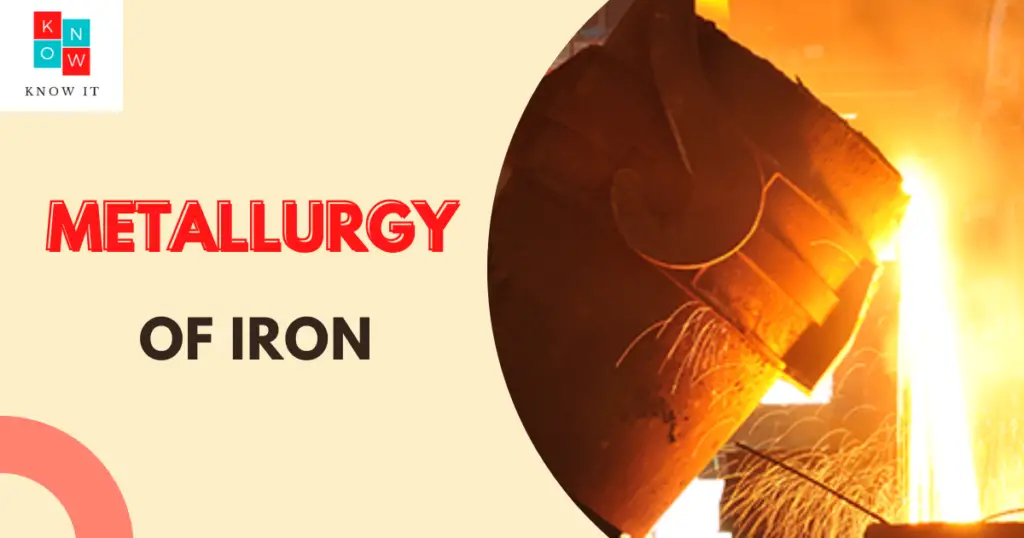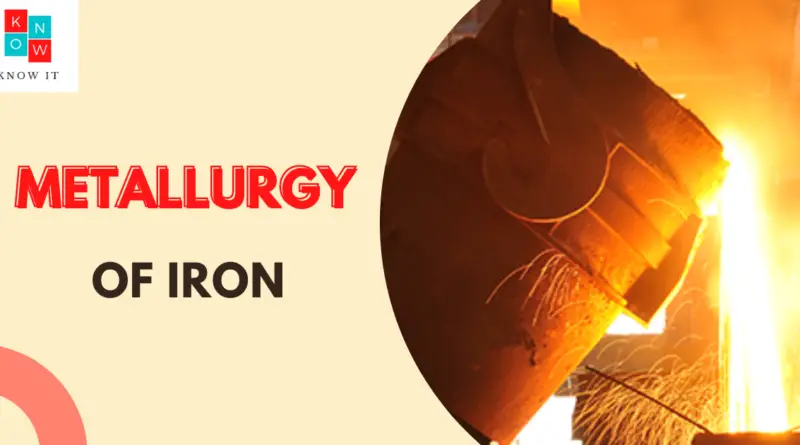Metallurgy of Iron
This guide will teach you all about the metallurgy of iron. You’ll learn how to process iron ore, and how to produce steel. The production of steel is a complicated process that takes place in a blast furnace with coke or natural gas and oxygen. The conversion of the ore into liquid iron requires temperatures around 1500 degrees Celsius, which can only be achieved in a blast furnace by using coke or natural gas as fuel.
The word “metallurgy” comes from the Greek words “metallon,” meaning metal, and “ergon,” meaning work. Metallurgy is the science that deals with extracting metals from their ores and refining them into purer forms for use in manufacturing processes such as forging, casting, or machining.

Iron ore is a mixture of metallic oxides, silicates, and carbonates. The iron ore can be classified by the type of rocks it was formed from (e.g. pyrite and marcasite), where the ores are found, what metals are present in them (e.g., magnetite), or even the color of the ore. Iron ore can be found in many different countries, including China, the USA, Brazil, Australia and India. The types of rocks that iron ore is formed from vary depending on the location it is found. For example, in North America it will form mostly from Precambrian metamorphic rocks like schist and gneiss while in South America it will form from sedimentary rocks like sandstone. Iron ore is often formed from slags, vents and volcanoes in which low-grade iron ore is deposited during the early stages of igneous activity.
Metallurgy of Iron - Ore Processing
Iron ore processing is a major industry worldwide. Iron is one of the most important metals and it is used in all kinds of things – from cars to skyscrapers.
The first step in iron ore processing is the extraction of iron from its natural form. This can be done by either mining it or by using a blast furnace to reduce it from other ores, such as hematite or magnetite. The mine or blast furnace will often apply various techniques, such as washing and drying the ore to separate ferrous from non-ferrous materials. The mineral is then crushed and ground into a fine powder or pellet. This powder is called “ore”. Next, it is heated in a high temperature oven to drive off the soluble products of oxidation, leaving behind the oxides of the metal which can be more easily separated by further crushing.
Ores are generally processed in a mill, which has a series of grinding wheels to crush and break up the ore. The crushed ore is screened or washed to remove impurities, such as clay, sand and quartz. The slurry is then heated to drive off any soluble products of the ore, including the dissolved metal minerals and the water produced. The slurry is then cooled and solids deposited at the bottom of the mill.
The mill is usually a large, fixed structure with rotating grinding wheels on an upper level that crush ore to a fine powder below. Mechanical hammers are used to screen and wash away any debris left after crushing that could clog the discharge pipes. The process is repeated through a number of stages, each time concentrating the ore in the slurry to extract more iron and other minerals. The entire process takes three to five hours.
After milling, the slurry is repeatedly clarified by draining it, filtering it using a weir system or centrifuging it and then dec anting or centrifuging it again. The waste liquid is then collected and separated from the solid residue. There are two types of mills: those that crush and grind raw materials into a fine powder, and those that cut ore particles into smaller pieces in order to facilitate the separation process.
The next step in the process is to remove impurities, such as sulfur and phosphorus, so that they don’t interfere with the smelting process. Finally, the purified iron must be heated until it melts and then cast into ingots for shipment or use.
Metallurgy of Iron - Steel Production
This section is about the process of steel production and how it has evolved over time. It will also discuss the various types of steel that are used today. The process of steel production has evolved over time, and there are many different types of steel used today. The most common type of steel is high-carbon steel, which is the most widely used steel today. High-Carbon Steel is typically a mixture of iron and carbon, with a small amount of other elements to make it harder. This type of steel was developed in England in the 19th century.
The process for making high-carbon steel starts with burning coal to produce coke, which is a type of fuel made with coal. The heat and pressure generated during the combustion of coke can melt sand into pig iron. The molten pig iron is poured into a mold in order to cool and solidify the metal, allowing it to be shaped into whatever shape desired.
The next step in this process would be using a blast furnace to produce pig iron. The blast furnace uses high-pressured oxygen and coal gas to make it possible to melt pig iron in a gas environment. It is also possible for the blast furnace to use natural gas, but this is less common because the heat needed for this process would need to be produced with a steam turbine, which would use a great deal of fuel.
Pig iron is used in a blast furnace to make steel. Coal gas and oxygen are blown in high-pressure into the molten iron, causing it to melt. This process gets rid of most of the carbon and impurities in the pig iron, leaving behind purer metal. Steel is made by repeatedly heating and cooling this pig iron until it becomes malleable.
Ingots & Steel Pipes
Steel ingots are a type of raw material that is used to make steel pipes. Steel pipes are used in the chemical industry and in construction. Steel ingots, then, are an integral part of the steel pipe manufacturing process.
Steel pipes are typically made from steel ingots by rolling them into thin sheets that can be formed into different shapes, such as tubes or pipes. The quality of the steel pipe depends on the quality and thickness of the sheet that is rolled from it.




Your articles are extremely helpful to me. Please provide more information!
Your articles are extremely helpful to me. Please provide more information!
Thank you for writing this article. I appreciate the subject too.